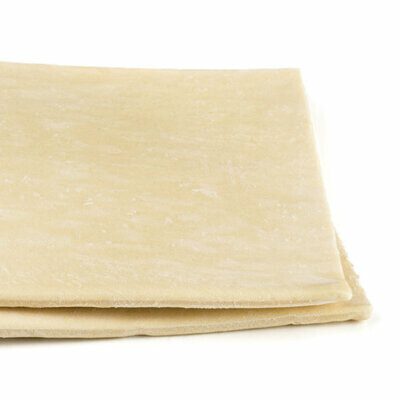
Dough Sheeting
What is Dough Sheeting?
In baked goods production dough sheeting is the act of flattening a dough piece. The starting dough piece can be used for either pan bread or laminated products.
- Sheeting can be done mechanically using dedicated machines, or manually.
- The most basic design for a dough sheeter consists of two stainless steel rollers between which the dough is passed for sheeting instead of rolling by hand with a rolling pin.
How it works
In breakmaking bakeries, a sheeter consists of a series of gauge rolls (usually two sets) that gradually transform a rounded dough piece into a dough disk. The dough piece is then curled and molded into a cylinder- or loaf-type piece that suits pan dimensions for final proofing.
Dough sheeting for optimum crumb grain
Dough sheeting modifies the original arrangement of polymeric gluten strands by extending or stretching them on a horizontal axis due to compression forces. Ideally, the dough piece is sheeted out as thin as required without tearing the dough, bursting gas cells, or damaging the gluten network, both key aspects for optimum gas retention during proofing and baking.1
Besides the obvious effect on dough shape, one key purpose of sheeting is to subdivide the gas cells incorporated and trapped in the dough during mixing. Thanks to gas cells subdivision, provided proper emulsification, coalescence phenomena in the expanding dough is further limited so a finer crumb grained and blisterless product can be achieved in the baked product.
Application
Pan bread dough sheeting
After bulk dough has been divided and rounded, the dough ball enters the sheeting equipment. In high-speed bread lines, a sheeter consists of two sets of gauge rolls, a top (head) and a bottom set.
The gap between top rollers is wider than that in bottom rollers to accommodate the initially much thicker dough piece. The setting of head and bottom rolls depends on the size (scaling weight) and condition of the dough piece. Thus, a 23 ounce (650 g) dough piece will require the rolls to be set farther apart than a 18 ounce (510 g) dough piece.
Loose sheeting rolls yield thick dough sheets (disks) that will not produce a sufficient number of curls upon rolling (3 to 4 rolls are suggested for standard pan bread). In some cases, loose sheeting rolls can create blisters on the surface of the moulded dough piece.
The physical condition of the dough leaving the divider and going into the makeup stage is of vital importance for its performance during sheeting and moulding. In flourless makeup lines, a deformable, highly extensible and somewhat dry dough is essential to prevent dough from sticking to conveyor belts, rollers and pressure boards at the moulder. A properly formulated and mixed dough will be easy to round, sheet, curl and mould to produce well-shaped, uniform loaves.
Roller adjustments during sheeting
|
Sheeting roll set is too open (gap too wide) |
Sheeting roll set is too tight (gap too narrow) |
|---|---|
|
|
Sheeting roller considerations in high-speed bakeries
- The condition of the rolls should be checked on a regular basis. There should be no dents or build-up of dry dough on the rollers.
- The scrapers on each set of rollers should be set to specifications by the engineering and maintenance personnel to allow the dough piece to be pulled away from the rollers without tearing. The scrapers should be kept clean and free of build-up. The equipment should be locked-out prior to removing the guards.
- Rollers are generally made of Teflon to avoid dough stick-up or build-up and to lessen the amount of dusting flour needed.
References
- Cauvain, S.P. “Mixing and Dough Processing.” Technology of Breadmaking, 3rd edition, Springer International Publishing Switzerland, 2015, pp. 101–143.

